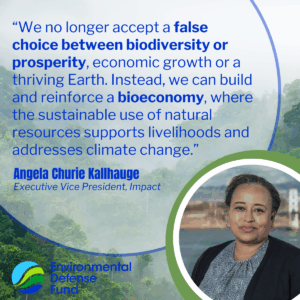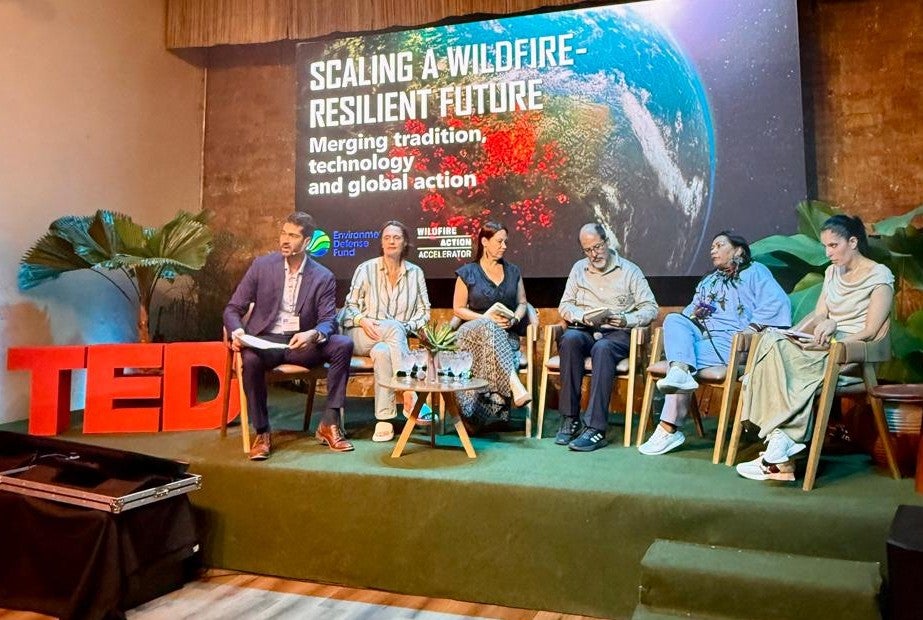
From IUCN Congress to COP30, let science, Indigenous knowledge, and economics lead toward solutions that work for people and nature
This October, a rare, once-every-four-years gathering is taking place in Abu Dhabi: The IUCN World Conservation Congress is where global experts and leaders meet to discuss nature conservation. It’s not just about protecting wildlife; it’s a vital opportunity to find smart, practical, and science-backed ways to meet our 2030 goals for people and nature. This event is a key moment to advance actions that tackle the connected problems of biodiversity loss and climate change together—a collaborative effort, much like the UN’s “Rio Trio” agreements, that could accelerate global action.
This Congress comes just weeks ahead of the next United Nations climate conference, COP30, which will take place in the Amazon Basin, hosted by the city of Belém, Brazil. Hosting in this setting gives us the opportunity to cast global attention to the challenges and potential solutions unfolding in the wider Amazon region, for the communities living and sustaining the Amazon, and for biodiversity and nature at large.
As we prepare for IUCN, I’m reminded of what I learned during my trip to Kenya to visit the Maasai people and EDF’s new partners IMPACT Kenya. During our visit, I saw the value of rights-based, inclusive conservation firsthand: observing that land under indigenous community management was in much better condition than private conservancies. When we toured the Il Ngwesi Conservancy with Mali Ole Kaunga, the Founder of IMPACT Kenya, he shared that when the Maasai elders purchased the land in 1996, it became one of the first fully community owned and run conservancies in Kenya. And he shared a Maasai principle that guides their work, “if you take care of the land, the land will take care of the people.”
This lesson stuck with me, and it resonates now as we look to the Congress in Abu Dhabi. It’s a reminder that when we design and implement solutions that protect nature and our climate, we must make sure these solutions are in service, first and foremost, of improving lives and local economies so that people thrive.
We no longer need to make a false choice between biodiversity or prosperity, economic growth or a thriving Earth. Instead, we can build and reinforce a bioeconomy, where the sustainable use of natural resources supports livelihoods and address climate change.
Here’s how we’re working toward that goal at the IUCN World Congress:
Investing in and acting on emerging science
Alongside Indigenous leadership and traditional knowledge, we have to continue to invest in and act on emerging science. A critical area of emerging science is the role of the ocean’s mesopelagic zone.
The mesopelagic zone (200 to 1,000 meters deep) is home to over 90 percent of the ocean’s biomass. New evidence suggests that these organisms perform the largest daily animal migration on Earth, surfacing to feed and then traveling back down. This process traps millions of tons of carbon each year — six times more than the amount emitted by every car worldwide—helping the ocean absorb excess carbon from the atmosphere and lock it away in deep sediment.
However, industrial-scale fishing fleets are increasingly targeting this area.
Protecting this zone of our oceans is not just a climate and nature imperative, it’s also an economic imperative. The biological activity in the ocean’s mesopelagic zone locks away an estimated $300 to $900 billion worth of carbon every year. Such a loss in sequestration service could amount to between $23 to $401 billion in adaptation costs by the end of the century.
There is much to learn to ensure a precautionary approach is fully adopted before considering industrial exploitation. Attendees at the IUCN Congress can vote Yes on Motion 035, the protection of mesopelagic ecosystem integrity, to take a precautionary approach on the expansion of fishing and other exploitive activities until we better understand these ecosystems and can develop policies that sustainably balance ecological and human needs.
Supporting and applying traditional and Indigenous knowledge
Our path to a thriving future for people and nature must be built on supporting Indigenous leadership and leveraging Indigenous traditional knowledge. Research shows that forests within Indigenous territories often have lower rates of deforestation and degradation compared to lands outside of them, including state-managed protected areas.
EDF is working directly with Indigenous leaders from Kenya, Ecuador and Brazil in to amplify their voices and meaningful engagement in spaces like Climate Week NYC, IUCN Congress and COP30. For instance, at IUCN, I’m thrilled that our team will join our IMPACT partner Mali Ole Kaunga in a discussion on transforming conservation finance to uphold Indigenous rights. To join that discussion in Abu Dhabi, see more details here.
We encourage decision-makers at IUCN to scrutinize the range of proposed solutions before them for the incorporation of Indigenous knowledge and rights. This is not only just, but has been proven time and again to being one of the most effective approaches to nature conservation
Solutions that deliver for people, economies and nature
When we combine the latest science, deeply rooted traditional knowledge, and smart economics, we can design inclusive, economically sensible solutions. We’re seeing increased engagement and demand for new economic approaches and financing models that recognize IPLCs as economic agents, suppliers, and guardians of vital natural resources.
EDF collaborates with IPLCs to make forest finance accessible and support community-based ventures. Both JREDD+ (reducing deforestation) and the Tropical Forests Forever Facility (stable, long-term conservation funding) rely on effective forest protection, a role in which Indigenous peoples are proven to be the most effective. Direct funding strengthens local rights, autonomy, and capacity to continue this vital stewardship.
If you take care of the land, the land will take care of the people. It’s in the spirit of this Maasai principle that EDF is headed to the IUCN Congress, supporting solutions that balance traditional knowledge with cutting-edge science to design solutions that improve lives, build up local livelihoods, and protect nature and our climate. In so doing, we can shift the narrative to show that a thriving future for both people and nature is not only necessary, but achievable.












